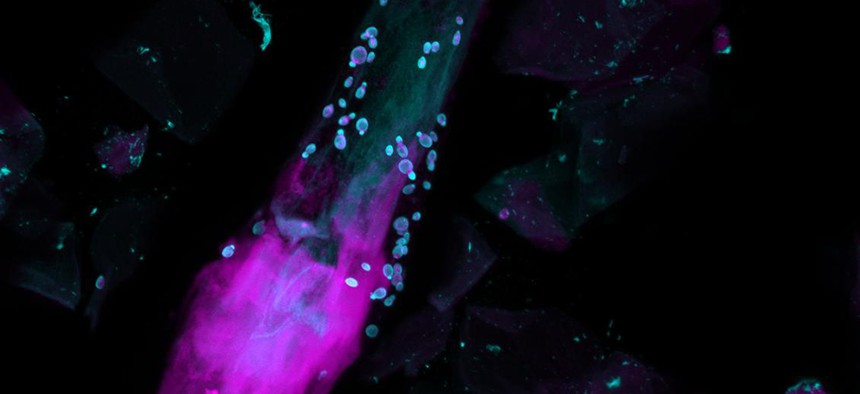
A fluorescent microscope image of a human hair shaft in the skin surrounded by bacteria (purple) and fungi (blue). Alex Valm, National Human Genome Research Institute, NIH
Yes, It’s True: There’s Fungus Among Us
NIH-funded research reveals our bodies are covered in fungus.
Athlete’s foot, ringworm, diaper rash, dandruff, some cases of sinusitis, and vaginal yeast infections are all caused by fungi. These microscopic co-travelers live in the air, water, soil, and, so it happens, on our body. NIH researchers have just completed the first census of the fungi that live on the human body, and it’s quite a diverse collection.
The researchers used Q-tips and toenail clippings to sample 14 sites from 10 healthy human volunteers and then analyzed the DNA to determine the identity of the fungi in these locations. They focused on sites—like the back of the head, nostril, feet, and groin, for example—that are frequently plagued with diseases thought to be caused by fungi. (The same team of researchers took a similar approach a few years back to catalog all the bacteria that live on human skin.)
Altogether, the DNA sequencing revealed 80 genera of fungi on the surface of our bodies. Fungi belonging to the genus Malassezia are by far the most common on the head and trunk. The hands, which are rich in bacteria, have relatively few types of fungi. But it’s the feet—the heels, the webbed skin between the toes, and the toenails—that harbor the most diverse collection of fungi, with up to 80 genera—including the yeast Saccharomyces that’s used to brew beer and make bread.
Toenail infections are notoriously difficult to eradicate. Interestingly, the researchers discovered that toenails foster unique collections of fungi. Some of these fungi can discolor and break the toenail, creating portals through which other pathogenic bacteria and fungi can enter the body.

Human Skin Fungal Diversity. The fungi Malassezia (purple) dominates the majority of the body sites. The feet harbor the greatest diversity of fungi. Credit: Darryl Leja and Julia Fekecs, National Human Genome Research Institute, NIH.
Together, all of these studies reveal that the skin is an incredibly dynamic and complex ecosystem teeming with bacteria, viruses, and fungi that interact with each other and with us, their hosts! This census gives us the opportunity to investigate how all these microorganisms network, what they do for us, and what we do for them. That’s vital, because certain microbes are needed for healthy skin, while others cause disease or set the stage for them.
The skin isn’t the only location that harbors fungi. Just last year, an NIH-supported team based at Cedars-Sinai Medical Center, Los Angeles, showed that there’s a rich community of fungi co-existing with bacteria in the human intestine.
About 29 million Americans suffer from fungal infections. Many of those are just bothersome skin problems—but fungi can also cause life threatening lung problems (like Valley Fever in the Southwest United States) or meningitis (as recently reported in hundreds of individuals after epidural injections of a contaminated steroid preparation). Most current oral antifungal medications have serious side effects, including liver and kidney damage. To develop safer drugs and vaccines, we need a better understanding of our fungal friends and foes. The use of genomic sequencing to take the census of these microbes opens a new chapter in understanding health and disease.







